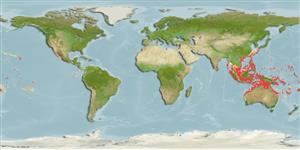>
Eupercaria/misc (Various families in series Eupercaria) >
Labridae (Wrasses) > Corinae
Etymology: Halichoeres: Greek, als, alis = salt + Greek, choiros = pig (Ref. 45335).
More on author: Randall.
Environment: milieu / climate zone / depth range / distribution range
Ekologi
laut berasosiasi dengan karang; kisaran kedalaman 2 - 70 m (Ref. 90102), usually 15 - 60 m (Ref. 27115). Tropical; 24°C - 27°C (Ref. 27115); 32°N - 32°S
Eastern Indian Ocean: Christmas Island. Western Pacific: Solomon Islands, north to southern Japan, south to Rowley Shoals and New South Wales (Australia). Recently reported from Tonga (Ref. 53797). Replaced by Halichoeres leucoxanthus in the Indian Ocean, but with overlapping distributions in Indonesia (Ref. 37816).
Size / Weight / umur
Maturity: Lm ? range ? - ? cm
Max length : 12.0 cm TL jantan/; (Ref. 2334)
deskripsi pendek
Kunci identifiaksi (pengenalan) | Morfologi | Morfometrik
Duri punggung (Keseluruhan (total)) : 9; duri punggung lunak (Keseluruhan (total)) : 12; Duri dubur: 3; Sirip dubur lunak: 11 - 12; vertebrata, bertulang belakang: 25. In life, body bright yellow, head and thorax yellow-orange; a spot behind eye; head with irregular light-green bands. Dorsal fin of males with a large black, white-rimmed spot at the first interspinous membrane (another spot may appear on the soft portion between 2nd and 3rd rays for smaller males); females with a second black, light yellow-rimmed spot; smaller females and juveniles with a third blackish spot on penultimate membrane. Anterior lateral line scales with 2-4 pores; 6-12 suborbital pores. Pelvic fins not reaching anus.
Found at the reef edge, in sand and rubble areas (Ref. 9710) usually in small groups (Ref. 90102).
Life cycle and mating behavior
Kematangan | Reproduksi, perkembang biakan | Pemijahan | telur-telur | Fecundity | Larva
Distinct pairing during breeding (Ref. 205).
Randall, J.E., G.R. Allen and R.C. Steene, 1990. Fishes of the Great Barrier Reef and Coral Sea. University of Hawaii Press, Honolulu, Hawaii. 506 p. (Ref. 2334)
Status IUCN Red List (Ref. 130435: Version 2024-2)
ancaman kepada manusia
Harmless
penggunaan manusia
Perikanan: komersial; Akuarium: Komersial
Alat, peralatan
laporan khas
muat turun XML
Sumber internet
Estimates based on models
Preferred temperature (Ref.
123201): 25.2 - 28.9, mean 27.7 °C (based on 662 cells).
Phylogenetic diversity index (Ref.
82804): PD
50 = 0.5000 [Uniqueness, from 0.5 = low to 2.0 = high].
Bayesian length-weight: a=0.00977 (0.00468 - 0.02039), b=3.09 (2.92 - 3.26), in cm total length, based on LWR estimates for this Genus-body shape (Ref.
93245).
Trophic level (Ref.
69278): 3.4 ±0.5 se; based on size and trophs of closest relatives
Daya lenting (Ref.
120179): Tinggi, Waktu penggandaan populasi minimum kurang dari 15 bulan (Preliminary K or Fecundity.).
Fishing Vulnerability (Ref.
59153): Low vulnerability (10 of 100).
Nutrients (Ref.
124155): Calcium = 97.2 [58.1, 171.5] mg/100g; Iron = 0.782 [0.459, 1.453] mg/100g; Protein = 18.4 [15.5, 20.6] %; Omega3 = 0.178 [0.111, 0.283] g/100g; Selenium = 27.2 [16.0, 49.4] μg/100g; VitaminA = 147 [45, 555] μg/100g; Zinc = 1.8 [1.2, 2.8] mg/100g (wet weight);
